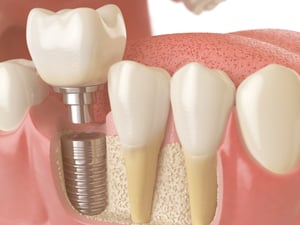 If you don't have sufficient amount of healthy bone in your jaw to support your dental implants, you may need bone grafting.
If you don't have sufficient amount of healthy bone in your jaw to support your dental implants, you may need bone grafting.
What is bone grafting?
Bone grafting is surgical procedure that transplants healthy bone tissue to recreate bone and supporting tissues that are missing. Dental implants rely on osseointegration in order to work, meaning the implant has to bond with the bone to create a stable foundation for the crown. If there is no bone to work with, placing an implant becomes impossible.
Types of bone grafts
- Socket graft. This is the most common bone graft procedure, which involves placing new bone directly into the socket where the tooth has been removed to create a strong base for the dental implant.
- Block bone graft. This type of graft is performed when there has been an injury or trauma to the jaw, so there is extensive bone loss. The bone is sourced from the back of the jaw and held in place with titanium screws until it bonds with the surrounding bone tissue.
- Lateral ridge preservation graft. When the patient's jaw is not wide enough to support an implant, human bone is used to increase the width of the jaw.
- Sinus lift procedure. When there is a need for an implant in the upper jaw, it is common practice to use this type of bone graft because the upper jaw is usually not stable enough to hold an implant on its own. The bones are added to the sinus cavity to promote bone growth in the area.
How does bone grafting work?
Before the surgery, anesthesia is administered to prevent any discomfort. The dentist cleans the area, then makes an incision through the gum tissue to expose the area that requires the bone graft. The dentist will then take a section of bone from another area of your body, or use a special bone grafting material, and graft it onto your jaw bone where it's needed.
The healing time may take several months to allow for the jawbone to regenerate in order for the dental implants to be placed securely. After implants are placed, you will need several more weeks to heal and to allow the implant to bond with the bone before the abutment and crown can be attached.
While your jaw bone is healing, it is essential to follow proper aftercare instructions provided by your dentist, like not touching the wound, practicing good oral hygiene, only eating soft foods (e.g. mashed potatoes, oatmeal, smoothies), and using daily warm salt water rinses.
What are the risks and side effects of bone grafting?
As with any surgical procedure, certain side effects and complications are possible.
Normal side effects of a bone graft procedure include:
- Gum swelling
- Skin swelling or bruising
- Minor bleeding
- Difficulty eating, speaking, and chewing
In rare cases, bone grafting can have more serious complications, which include:
- A negative reaction to anesthesia during the procedure
- Pain, swelling, and/or inflammation around the donor and grafting site
- Bleeding or infection
- Injuries affecting your nerves
- Your body may reject the bone graft
- Your body may reabsorb the graft
It is important to speak with your dentist about all the risks and benefits of the bone grafting procedure, as well as your medical history, to see if the procedure is right for you.
Who is a good candidate for bone grafting?
You may be a good candidate for bone grafting if you experience any of the following:
- Your adult tooth has been extracted or is missing, the bone around your tooth can start to disappear.
- You have gum disease, which may cause the jaw bone to recede.
- You have developmental defects.
- You have had an injury or trauma to the face.
In summary, if you are considering implants, you must have healthy gums and adequate bone to support the implant. If your bone is too thin or soft, you may require a bone graft. Once your dentist determines that you are a good candidate for bone grafting and dental implants, you will be on your way to enjoying your new, healthy smile.
If you are interested in dental implants, call our office at (925) 705-7093 to schedule a consultation or use the button below to request an appointment online.


.jpg?width=712&name=GSD-Scalloped-Tongue-Causes-and-Treatment-Blog-01.27.2210.21.21%20(1).jpg)











.jpeg?width=425&name=GSD-How-to-Combat-Dental-Plaque-07.22.24-2%20(1).jpeg)



